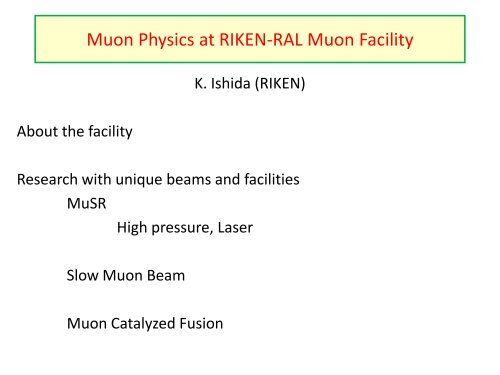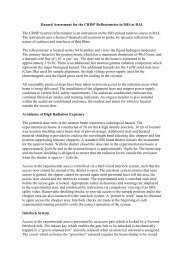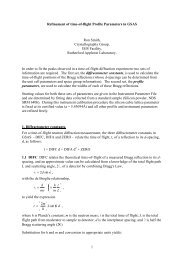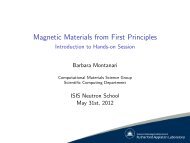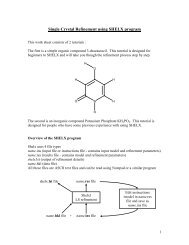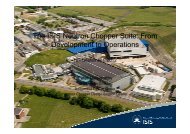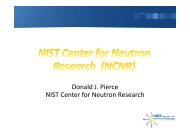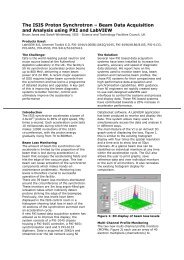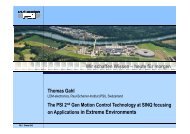riken - ISIS
riken - ISIS
riken - ISIS
- No tags were found...
You also want an ePaper? Increase the reach of your titles
YUMPU automatically turns print PDFs into web optimized ePapers that Google loves.
Muon Physics at RIKEN-RAL Muon Facility<br />
K. Ishida (RIKEN)<br />
About the facility<br />
Research with unique beams and facilities<br />
MuSR<br />
High pressure, Laser<br />
Slow Muon Beam<br />
Muon Catalyzed Fusion
Located at north-side of <strong>ISIS</strong><br />
RIKEN-RAL
RIKEN-RAL Muon Facility<br />
Construction Stage (1994)<br />
Recent
About RIKEN-RAL<br />
It is operated by Japanese RIKEN Institute – since 1994.<br />
It is open to users through RIKEN PAC and <strong>ISIS</strong> PAC.<br />
RIKEN-RAL has many features in common with EC Muons,<br />
but also has some unique features.<br />
Backward decay muon beam<br />
as well as surface muon beam<br />
can be chosen at RIKEN-RAL Muon,<br />
because of the solenoid decay section.<br />
Proton beam<br />
Carbon target<br />
Positive pion<br />
Negative pion<br />
Superconducting solenoid<br />
confinement magnet<br />
Pion<br />
Muon
Unique capabilities at RIKEN-RAL<br />
Compared with surface-muon beam,<br />
backward decay muon beam has<br />
advantages<br />
- higher momentum (thick samples) m+, m -<br />
- choice of positive/negative muon<br />
disadvantages<br />
- lower muon stopping density (difficulty with small samples)<br />
And also, unique facilities<br />
1) Laser MuSR<br />
2) Slow muon with laser
1. MuSR at ARGUS<br />
Muon Physics at RIKEN-RAL<br />
Laser, High pressure, …<br />
2. Slow Muon Beam<br />
3. Muon Catalyzed Fusion<br />
with negative muon
mSR (ARGUS)<br />
mSR with surface/decay muon beam<br />
under various target conditions
mSR at RIKEN-RAL<br />
ARGUS Spectrometer<br />
Highly segmented detector (96+96)<br />
High data rate (70 M/hr)<br />
Magnetic field up to 0.4 T (LF) and 0.015 T (TF)<br />
Various cryostats (dilution, 3He, He, Flow type)<br />
Choice of backward decay or surface muon<br />
high momentum muon for high pressure chamber<br />
Other capabilities<br />
coupling with laser excitation, high pressure
MuSR with Laser<br />
Laser has many good features<br />
intense photon<br />
good energy resolution, variable wave length<br />
polarized photons<br />
short pulse<br />
though<br />
it is not cheap, need some expert, safety issue etc<br />
Intense pulsed laser is a good match for pulsed muon<br />
Laser facility started in RIKEN in Feb 2008
Installed laser system (RIKEN Port 2)<br />
Nd:YAG (1064 nm;<br />
532 nm; 355 nm)<br />
+<br />
OPO<br />
Pulse repetition rate<br />
Pulse duration (FWHM)<br />
Pulse energy @ 1064 nm<br />
Pulse energy @ 532 nm<br />
Pulse enery @355 nm<br />
OPO energy 420-700 nm<br />
(signal)<br />
OPO energy 700-2600 nm<br />
(idler)<br />
25 Hz<br />
8 ns<br />
1400 mJ<br />
600 mJ<br />
350 mJ<br />
~ 10 7 times faster<br />
Laser for Chemistry:<br />
Mu + H 2 → MuH + H reaction rate<br />
Precise calculation of potential surface and reaction rate is<br />
one of the fundamental chemical physics problem<br />
Unprecedented new tests will be possible using H2 in v=1 excited<br />
state
Laser for Chemistry: H2 target<br />
High pressure H2 gas (50 bar)<br />
to increase the reaction rate, number of excited molecules<br />
need a maximum overlap of the muon beam and the laser beam<br />
532 nm<br />
reflector<br />
683 nm<br />
reflector<br />
Muon<br />
beam<br />
H 2<br />
L<br />
Muon<br />
window<br />
(4x40<br />
mm)<br />
Optical<br />
window<br />
683 nm<br />
reflector<br />
Max practical working pressure 50 bar H 2
Laser for Chemistry: Result (Preliminary)<br />
A large laser ON-OFF effect was observed – first result<br />
Mu polarization lost by Mu+H2*<br />
Preliminary
Muon for Spintronics: Muon probing electron spin<br />
Polarization photon is easily obtained<br />
It can be used for polarization phenomena:<br />
good match for polarized muon also<br />
Monitor of polarized conduction electron is one example.<br />
Large laser ON/OFF,<br />
and left/right polarization effect<br />
Preliminary<br />
Application of laser is not limited.
Gas Pressure<br />
High pressure MuSR<br />
Hydrostatic Pressure<br />
6.4 kbar, 1.5 K<br />
10 kbar, 30 mK<br />
120 MeV/c muon can penetrate 2 cm of copper walls
H int = / m (gauss)<br />
A(t)<br />
What High Pressure can do?<br />
For example<br />
pressure decrease the lattice constant<br />
-> Magnetic interaction between spins can be increased<br />
Shift of frequency, new magnetic phase, …<br />
m<br />
H int<br />
TlCu 1-x Mg x Cl 3 (x = 0.015)<br />
ZF-mSR<br />
T = 2.3 K<br />
0 kbar<br />
500<br />
400<br />
300<br />
TlCu 1-x Mg x Cl 3 (x = 0.015)<br />
ZF-mSR<br />
T = 2.3 K<br />
0.525 kbar<br />
0.70 kbar<br />
0.95 kbar<br />
200<br />
1.5 kbar<br />
2.0 kbar<br />
100<br />
0<br />
0 1 2 3<br />
P (kbar)<br />
2 %<br />
0 0.5 1.0 1.5<br />
t (ms)
Asymmetry (%)<br />
New MuSR Spectrometer (CHRONUS)<br />
In order to meet high demands for MuSR opportunities at RIKEN-RAL<br />
New face to MuSR Spectrometer (in RIKEN Port4 )<br />
ARGUS CHRONUS<br />
Detectors 96+96 300+300<br />
Max Field 0.4 T 0.4 T<br />
Higher data rate<br />
Larger sample area<br />
20<br />
Cu<br />
LF<br />
100 G<br />
50 G<br />
20 G<br />
10 G<br />
5 G<br />
0<br />
0 5 10 15<br />
time (msec)<br />
0 G
1. MuSR at ARGUS<br />
Muon Physics at RIKEN-RAL<br />
Laser, High pressure, …<br />
2. Slow Muon Beam<br />
3. Muon Catalyzed Fusion<br />
with negative muon
Slow muon beam (Port3)<br />
Ultra slow muon beam by laser ionization of thermal muonium
Range<br />
Slow muons<br />
The surface muon beam make experiments possible<br />
with a thin sample (~100 mm)<br />
but still not enough to be used for very thin layer or interface<br />
To make it possible, slow muon beam is developed<br />
You will hear lots of applicationsat PSI from Dr. Salman<br />
with simple moderation, the energy<br />
is spread rapidly and we lose beam intensity<br />
mm<br />
mm<br />
1<br />
10 2<br />
10<br />
Cu<br />
bulk<br />
1<br />
10 2<br />
thin films..<br />
nm<br />
10<br />
1<br />
1<br />
10 10 2<br />
10 3<br />
Energy [keV]<br />
10 4
Producing low energy muon with laser<br />
Thermal Muonium<br />
muons stopped in hot W film<br />
diffuse to surface and thermally emitted<br />
(with 4 % efficiency)<br />
+<br />
Laser ionization<br />
Thermal muonium + laser ionization<br />
1s -> 2p(122nm) -> unbound<br />
m<br />
PSI use other methods for slow m production<br />
(rare gas solid moderator)<br />
2P<br />
1S
Slow m: Comparison with the PSI method<br />
PSI: rare gas solid moderator emits ~15eV muons<br />
during moderation in rare-gas solid, energy loss process terminates<br />
below energy gap in solid rare-gas film<br />
(Presentation by Dr. Salman)<br />
RIKEN-RAL: laser ionization method has achieved similar<br />
10 -5 ~ 10 -4 efficiency for the moderation<br />
PSI produces higher intensity low energy muons,<br />
Laser ionization method has several advantages<br />
smaller energy distribution (thermal)<br />
smaller spot size after acceleration from thermal energy<br />
timing capability (narrow pulsed beam controllable by laser timing)<br />
and potentially higher efficiency<br />
with improvement of laser power, etc<br />
We also aim to use slow muons for muon g-2 measurement.
Application of cold muon beam: muon g-2<br />
Muon is one of the most elementary particles, and<br />
its g-factor is one of the fundamental parameters.<br />
It is also related to muon spin precession frequency.<br />
The difference (g-2) from pure Dirac particle expectation<br />
is by vacuum polarization<br />
and sensitive to new particle, new physics.<br />
Most precise measurement was achieved at BNL, NY.<br />
Its measures precession of muon in the storage ring.
muon g-2 experiment<br />
Acceleration of slow muon makes cold muon beam<br />
with small spread of size and momentum (even if it’s at high energy)<br />
We can store the beam in compact muon storage ring to measure<br />
muon g-2 precisely.<br />
@BNL (~14m)<br />
@RAL->@J-PARC (~1m)
Key to increasing the slow muon intensity<br />
Intense generation of cold muon is a key for precision measurement<br />
Good intense surface muon source<br />
several developments are in progress<br />
High muonium yield in vacuum<br />
target search & development<br />
High intensity ionizing laser generation<br />
and ionization process<br />
Good slow muon beam optics<br />
without beam heating, low background
Search for Muonium emitting target<br />
We have started search for various porous materials<br />
Muon stop in bulk -> muon emission to void -> muon diffuse through<br />
void channels -> emission to vacuum<br />
Silica Aerogel<br />
Silica Powder<br />
Porous Silica<br />
Mu
Laser Development at RIKEN<br />
Under development by RIKEN laser group with latest laser technology<br />
To increase laser power by two orders
Laser intensity and Mu Ionization<br />
Estimation of ionizing process versus<br />
laser intensity<br />
based on rate equation & transition rate<br />
Olad laser system<br />
Case for I(Lyman-a) = 1 mJ,<br />
I(355) = 300 mJ<br />
length=4ns<br />
ionization 0.11 (??)<br />
New laser system<br />
Case for I(Lyman-a) = 100 mJ<br />
I(355) = 300 mJ<br />
length = 1ns<br />
gives ionization efficiency = 0.76 after 1 ns
1. MuSR at ARGUS<br />
Muon Physics at RIKEN-RAL<br />
Laser, High pressure, …<br />
2. Slow Muon Beam<br />
3. Muon Catalyzed Fusion<br />
with negative muon
mCF (Port 1)<br />
Muon catalysis of dt nuclear fusion
Negative Muon<br />
Positive muon mostly stays at interstitial site or makes chemical<br />
bonding like a hydrogen<br />
while<br />
Negative muon behaves as “a heavy electron” (m m = 207 m e ).<br />
m - is attracted by the positive charge of a nucleus<br />
and forms a muonic atom<br />
The muonic atom typically has 1/200 times smaller size than a<br />
normal atom, and its binding energy is 200 times larger.<br />
An example<br />
Muon Catalyzed Fusion
MuCF: Introduction<br />
Muon Catalyzed Fusion<br />
=> A negative muon can catalyzes nuclear fusions<br />
via the formation of muonic atoms and molecules
dt fusion in muonic molecule<br />
thermo nuclear (plasma) fusion<br />
muonic molecule<br />
t<br />
d<br />
t<br />
μー<br />
d<br />
high temperature overcome<br />
the Coulomb barrier<br />
Coulomb barrier is largely shielded<br />
by muon’s negative charge<br />
=> dt fuse in 10 -12 s in molecule
mCF Cycle<br />
After injection of muons into D/T mixture<br />
Formation of muonic atoms and molecules<br />
d-t fusion in small dtµ molecule<br />
muon released after d-t fusion<br />
- muon works as catalyst –<br />
Why not make a MuCF reactor?
neutron yield<br />
Maximizing µCF efficiency<br />
Fusion Energy<br />
~120 fusions per muon (2 GeV)<br />
/ muon production cost ~5 GeV<br />
= ~40% the scientific break-even<br />
Increasing the efficiency is the key<br />
(1) Cycling rate l c (↑) (vs l 0 : muon life)<br />
dtµ formation :tµ + D 2 →[(dtµ)dee]<br />
(2) Muon loss per cycle W (↓)<br />
muon sticking to a-particle, etc<br />
W<br />
φλ c<br />
l c<br />
Fusion per<br />
Muon<br />
Number of fusion per muon:<br />
Y n = fl c /l n = 1 / [(l 0 /fl c )+W] (↑)<br />
Yn<br />
exp(-λ n t)<br />
time
Dedicated mCF facility<br />
with safe tritium handling
~<br />
~<br />
~<br />
~<br />
~<br />
~<br />
MuCF target and detectors<br />
2.4T magnets for strong focusing of muon beam<br />
in 1 c.c liquid D/T target<br />
NE213 neutron detector<br />
Si(Li) X-ray detector(muonic atom X-ray)<br />
me decay detector<br />
Superconducting<br />
magnet<br />
Si(Li) X-ray<br />
detector<br />
90 400<br />
Be<br />
Windows<br />
µe<br />
counters<br />
840<br />
Muon<br />
D-T<br />
Target<br />
Neutron detectors<br />
0 100mm
Muon Catalyzed d-t Fusion<br />
<br />
Fusion neutron spectrum<br />
n<br />
Energy<br />
14 MeV<br />
Timing<br />
n- spectrum<br />
a<br />
b
MuCF topics at RIKEN-RAL<br />
muCF in D/T targets with controlled molecular states<br />
to better understand the basic process<br />
to achieve higher rate<br />
muCF in high density/high temperature target<br />
muCF under unexplored condition,<br />
large increase is expected<br />
Many other issues on basic processes<br />
Muon transfer between isotopes (d, t)<br />
Muon transfer to helium<br />
muCF of other isotopes
Summary<br />
RIKEN-RAL Muon Facility<br />
has been operating since 1994<br />
It can deliver both backward decay m + / m - and surface m + beam.<br />
Scientific research<br />
1. For mSR, RIKEN-RAL has optional features such as<br />
Use of laser<br />
Use of high pressure<br />
and good spectrometers (ARGUS, CHRONUS)<br />
2. RIKEN-RAL has also unique program using muons.<br />
slow muon beam development (for MuSR, muon g-2)<br />
muon catalyzed fusion
about RIKEN<br />
RIKEN (RIkagaku KENkyujo, The Institute of Physical and Chemical Research)<br />
is one of the largest basic research institute in Japan<br />
covering physics, chemistry as well as biology with ~3,000 staffs.<br />
RIKEN was established in 1917.<br />
The second cyclotron in the world was built there in 1937.<br />
The world largest SC cyclotron (8300 ton) has started operation in Dec 2006.<br />
It provides heavy ion (450 MeV/u) and RI beam for nuclear physics research.<br />
RIKEN-RAL Muon Facility was funded, constructed and maintained by RIKEN.<br />
1937<br />
(World’s second cyclotron)<br />
2006<br />
(Largest cyclotron in the world)


